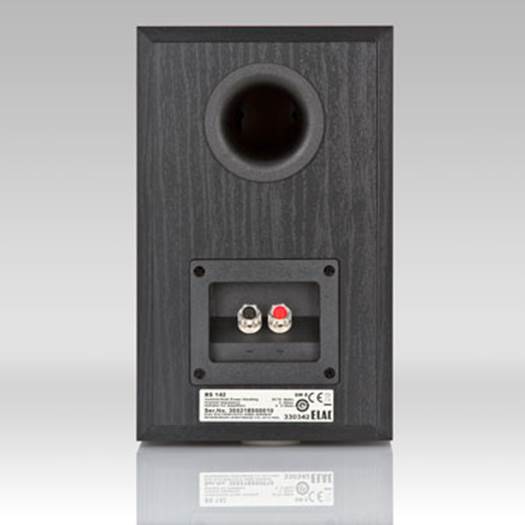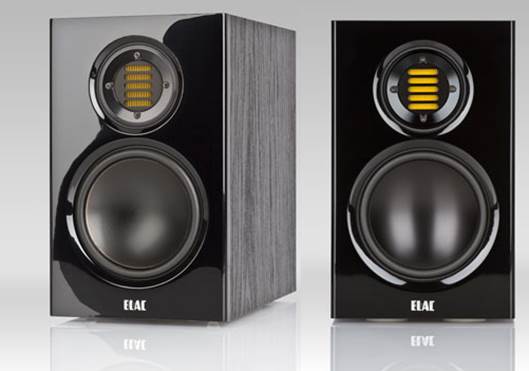Just another mid-price stand mounting
speaker? Not likely! We find Elac’s BS 142 JET to be something out of the
ordinary...
Defining new boundaries, Elac’s BS 142
compact stand mount speaker is a two-way design that unusually offers a ribbon
tweeter, instead of the standard-issue fabric dome normally found at this
price. This type of tweeter should give smoother, cleaner treble than is
available from some of the other methods of construction, as well as extended
frequency response which carries on well beyond the bounds of what is normally
considered to be audible. This is because the ribbon diaphragm is much thinner
(hence lighter) than stock cloth or metal domes, meaning faster transient
response, greater linearity and less distortion.

Elac
BS 142 Jet Loudspeaker
Ribbon tweeter aside, the BS 142 appears
essentially conventional, being housed in a simple rectangular box with a large
bass port at the rear. A pair of simple screw-type terminals permit cables with
both forked terminals and standard 4mm plugs to be used, but there are no
facilities for bi-wiring or bi-amping.
The woofer is interesting inasmuch as it
uses a sandwich-type cone where the outer layer obscures the end of the voice
coil, so that the familiar center dust cap isn’t visible. Even though you can’t
see them both the voice coil and its surrounding magnet are large, the former
has a diameter of 31mm, which allows for good heat dissipation when the
loudspeakers are being worked hard.
The main cabinet finish is a black ash
effect vinyl wrap, which is not particularly luxurious, but reasonably discrete
in the right surroundings and easy to keep looking presentable. The baffles are
made from high-gloss molded plastic and again have a clean, non-nonsense look
about them. Grilles are included and these fit into place on invisible magnetic
catches so there are no ugly holes in the baffles when they are not fitted.
A common misconception on the subject of
loudspeakers is that larger ones require more amplifier power than smaller ones
do. Often the precise opposite is true; attempts by manufacturers to obtain a
broad frequency spread from small cabinets result in poor sensitivity, meaning
that it takes a lot of watts to make a decent amount of noise. There are rare
exceptions and the Elac BS 142 is one since it has a claimed sensitivity of 88
dB/1W/1m. When I see figures like this, partnering with a 30W (or thereabouts)
amplifier springs to mind, given the scale of sound that one would expect and
the size of listening room in which loudspeakers like this are likely to be
installed in. This is excellent ‘starter system’ territory and I can see the BS
142 working well with high quality ‘style systems’, for example.
Sensitive loudspeakers are also often
chosen for use with valve amplifiers, where the pounds-per-watt ratio is often
considerably worse than it is with transistor models. While the basic figures
certainly stack up, I would advise some caution here since the BS 142 is very
generously ported and there appears to be little in the way of internal
damping, evidenced by the fact that you can see the back of the tweeter if you
look down the reflex port.

There
are rare exceptions and the Elac BS 142 is one – since it has a claimed
sensitivity of 88 dB/1W/1m
This type of construction tends to give
strong base for a given cabinet size, but does require an amplification setup
that offers a good damping factor to compensate for the mechanical freedoms
which the cabinet offers. High damping factors are typically achieved by using
powerful directly coupled transistor amplifiers and high quality loud-speaker
cables, by these means the signal is better able to place the woofer cone and
so it is less likely to flap about.
This box is all about giving a big,
punchy sound, something in which it excels
Small valve amplifiers tend to do poorly in
terms of damping factor, so I would hesitate to recommend a ported design for
use with them, unless you like a lot of bass and are not too troubled about
retrieving the rhythmic information that exists in the lower frequency ranges.
Elac do supply a foam bung which you can use to tune the bass ports to work
best in your surroundings, and comes in two sections. The middle part is
removable so that you can use the bung to just cause a restriction, rather than
blocking the entire port with it completely.

This
box is all about giving a big, punchy sound, something in which it excels
When auditioning loudspeakers like this I
prefer to place them well out into the room (about 1m from the back wall) and
with the ports open, this being one way to reduce coloration effects which have
more to do with the building than the loudspeakers. The source for the tests
was a Cyrus CD 8 SE CD player and an Arcam FMJ A38 amplifier, which is,
perhaps, a little large for the task at hand, but has more than enough power to
keep almost any loudspeaker under tight control. The cables used were from the
Chord Company, Odyssey II for the loudspeakers and Calypso for interconnects
between the Cyrus CD player and Arcam amplifier.